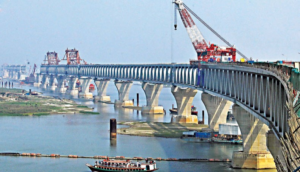
A New Age file photo of under-construction Padma Multipurpose Bridge.
by Dr. Rosy Shahjahan 30 June 2022
Chinese Ambassador to Bangladesh, Li Jiming said “The Padma Multipurpose Bridge” is a milestone in the field of China-Bangladesh cooperation. Quoting about Bangladesh’s dream projects he said “Whenever I think of the bridge, three words come to my mind: courage, determination and prosperity.” He also extended warmest congratulations to the people and government of Bangladesh for this outstanding achievement and urged that whenever President Xi Jinping mentions Bangladesh, he will mention the Padma Bridge. This is the largest bridge that Chinese enterprises had ever constructed outside China.
The history-making project, will serve as an everlasting bond of brotherhood between China and Bangladesh as a state-owned Chinese corporation, China’s Railway Major Bridge Engineering Company Ltd (MBEC), built the bridge. The project was meticulously constructed by MBEC with the feelings of the Bangladeshi people in mind. Following a proper procedure of international tendering, Bangladesh awarded the company the construction work. Government also authorized a joint venture between the China Major Bridge Engineering Company Ltd (MBEC) and the Korea Expressway Corporation (KEC) for ensuring maintenance and collecting tolls for the establishment after opening.
The nation’s longest (6.15 km), Padma Bridge, is scheduled to open on June 25 of this year, granting the long-held wish of the populace, particularly those from the southern areas. The double-decker bridge, which has a broad-gauge single rail track on the bottom and a four-lane road on top, is predicted to increase the nation’s GDP by 1.2 to 2 percent.
But at first, the Chinese corporation found it difficult to decide whether or not to submit the tender. There were fierce competitors from France, South Korea, and Singapore. The natural environment for the construction was challenging and unfamiliar. So, accepting the challenge was also a courageous step taken by the Chinese side that is most appreciable one. As accomplished, the bridge become the largest of that kind which Chinese engineering have ever built outside of China.
The Padma River’s distinctive hydrographic characteristics have presented the most difficult obstacle. The steel piles had to be driven 120 meters into the river bed because the sand and soft clay beneath the river were insufficient to hold the pillars. To move one pile into place, it typically took 20–30 thousand strokes. Three of the five cutting-edge hydraulic pile hammers, including the biggest one in the world, were damaged by the excessive workload.
The project involved 13 technologies that have never been used in the world, so the entire endeavor was full of experiments that no one had ever done before. The Chinese engineers of China Major Bridge Engineering Co. Ltd and Sinohydro Corporation Limited had to overcome the “unforeseeable physical conditions”, determine the actual parameters in the river, and then complete the task which was a daring one.
Even during the COVID-19 pandemic stuck down, the project was safeguarded the logistical line, provide close-loop housing for almost 3000 engineers and workers, record zero infections, and keep the construction process as uninterrupted as feasible.
The Padma rail link project that will pass through the bridge will become a sub-route of the proposed trans-Asian railway network. The multipurpose bridge after being put into operation, it is anticipated to raise the country’s GDP growth by 1.23 percent annually and by 2.5 percent in the south-western region. More than 80 million people, or around half of Bangladesh’s population, are expected to gain something from the bridge. Communication timing between capital Dhaka and the 21 southern districts will be reduced by two or four hours. Direct communication with the capital will facilitate industrialization, ease the delivery of raw materials, and promote trade and commerce. The 21 districts will be home to both small and large companies. Agriculture will advance significantly. Farmers will get better commodity prices thus both agricultural and industrial production will increase.
Building communication infrastructure is a key component to speed up Bangladesh’s growing economy which is presently the 41st largest in the world, is anticipated to grow to the 25th largest by 2035. Where the Padma Multipurpose Bridge would undoubtedly amplify economic maneuvers in Bangladesh though strengthened connectivity and would aid the nation to reach its goal of becoming a developed one by 2041.









